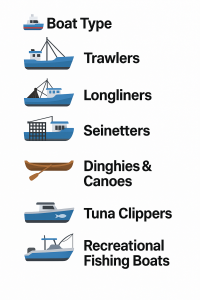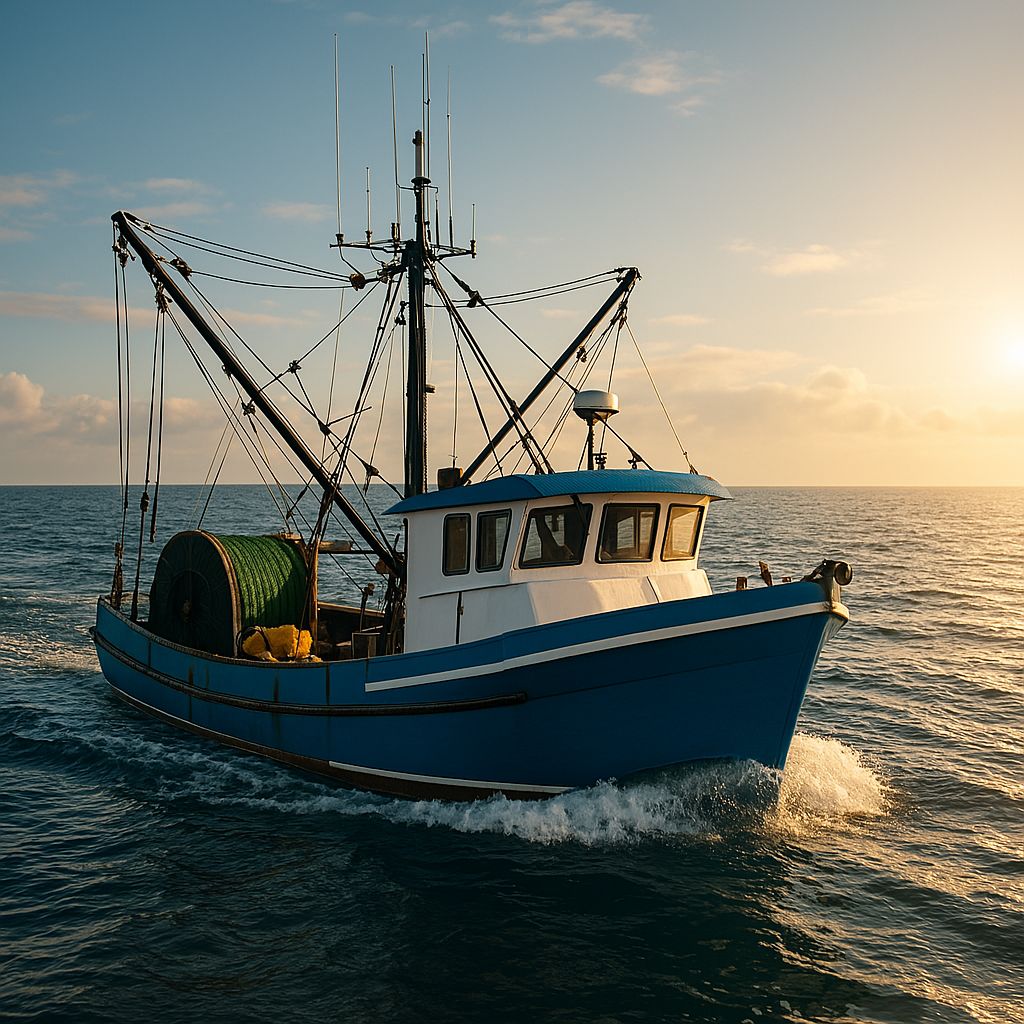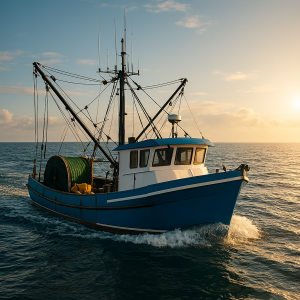Discover everything about fishing boats—from traditional vessels to modern technologies. This comprehensive guide covers types, uses, innovations, and trends for beginners, maritime professionals, students, companies, and enthusiasts alike.
Why Fishing Boats Matter More Than Ever
Did you know that over 4.6 million fishing vessels operate globally, supporting food supply, livelihoods, and maritime culture?
Whether you’re a curious beginner Googling “types of fishing boats,” a student studying vessel design, or a professional working in the fishing industry, understanding fishing boats is essential to appreciating their engineering, environmental, and economic impact.
What Is a Fishing Boat?
A fishing boat is any watercraft used to catch fish and other seafood from oceans, rivers, or lakes. From hand-built dugouts to high-tech industrial trawlers, fishing boats are essential in both small-scale artisanal fisheries and large-scale commercial operations.
🔍 Key Characteristics:
-
Designed for functionality, durability, and capacity
-
Vary widely by region, fishing method, and target species
-
Equipped with storage, navigation, and safety systems
⚓ Why Are Fishing Boats Important?
✅ For Beginners & Enthusiasts:
-
Enable recreational fishing on lakes, rivers, or coastal waters
-
Serve as platforms for learning marine navigation and safety
📖 For Students & Researchers:
-
Key focus in marine engineering, naval architecture, and sustainability studies
-
Subjects for analyzing hydrodynamics, propulsion systems, and gear optimization
💼 For Professionals & Companies:
-
Backbone of the global seafood supply chain
-
Generate billions in revenue through aquaculture, logistics, tourism, and more
🌍 For Local Communities:
-
Crucial for food security and economic independence
-
Represent cultural heritage in many island and coastal societies
🛥️Main Types of Fishing Boats

| 📍 Best Used In | 🎯 Typical Users | |
|---|---|---|
| Deep sea, offshore | Industrial/commercial fishing fleets | |
| Open ocean | Tuna, swordfish fisheries | |
| Coastal and pelagic zones | Catch schooling fish (e.g., sardines) | |
| Nearshore and estuarine areas | Artisanal and small-scale fishers | |
| Rivers, shallow lakes | Traditional, subsistence fishers | |
| Tropical seas | High-speed tuna fishing | |
| Lakes, rivers, coastal areas | Hobbyists, tourism operators |
🧭 Key Components of a Fishing Boat
⚙️ Standard Equipment:
-
Hull: Made of wood, aluminum, fiberglass, or steel
-
Deck Gear: Winches, cranes, net haulers
-
Fish Hold: Refrigerated or insulated storage
-
Navigation System: GPS, radar, sonar, AIS
-
Safety Gear: Life jackets, emergency beacons, fire extinguishers
💡 Specialized Tools:
-
Fish finders (echo sounders)
-
Autopilot systems
-
Live bait tanks
-
Onboard freezers and ice machines
🌐 Applications & Real-World Examples
🐟 Small-Scale Coastal Fisheries
In Indonesia and West Africa, small wooden boats support thousands of families, using simple nets or lines while preserving marine culture.
🛥️ Industrial Factory Trawlers
In Europe and North America, advanced vessels act as floating factories, processing tons of fish daily with integrated freezers, grading machines, and waste management systems.
🧪 Scientific Research Vessels
Modified fishing boats are used in:
-
Marine biodiversity surveys
-
Fish stock assessments
-
Pollution monitoring programs
📈 Trends & Innovations in Fishing Boat Design (2024–2025)
🌱 Green Propulsion Systems
-
Shift to hybrid-electric and LNG engines for reduced emissions
-
Solar-powered systems for small boats
🤖 Automation & AI Integration
-
Use of AI-assisted fish detection, auto-hauling gear, and remote monitoring
-
Automated logbooks and fleet tracking systems
🔧 Modular & Customizable Designs
-
Builders offering interchangeable deck layouts for multipurpose use
-
Ideal for artisanal fleets upgrading operations sustainably
📊 Smart Fishing Boats
-
Data-driven vessels using IoT sensors to optimize fuel use, temperature control, and catch reports
❓ FAQs: People Also Ask
❓What is the best fishing boat for beginners?
A small aluminum or fiberglass boat with a basic motor is a great start for lakes and rivers.
❓How much does a fishing boat cost?
-
Small recreational boats: $5,000–$25,000
-
Commercial vessels: $100,000 to several million USD
❓Do I need a license to operate a fishing boat?
Yes, most countries require a vessel registration, fishing permit, and sometimes STCW safety training, depending on the boat type and use.
❓What are the most sustainable fishing boats?
Boats using selective gear (e.g., circle hooks, TEDs), low-impact propulsion, and certified practices (e.g., MSC-certified fisheries) are considered sustainable.
📖 Interesting Facts & Statistics
-
🌍 Over 85% of the world’s fishing boats are less than 12 meters long (FAO, 2023)
-
🐠 The largest fishing vessel in the world can process over 250 tons of fish per day
-
⚓ In some countries, the fishing boat sector represents up to 10% of national employment
🧭 Conclusion
From hand-paddled canoes to cutting-edge factory trawlers, fishing boats power much more than fishing. They support coastal economies, advance marine science, offer outdoor adventure, and play a central role in maritime innovation.
Whether you’re building, boarding, buying, or blogging about boats—understanding their types, tools, and trends is key to navigating the waters of the global fishing industry.
🎓 Want to Learn More?
Explore more articles on marine vessels, sustainable fisheries, naval technology, and fishing gear at MaritimeEducation.com
📘 References & Further Reading
-
FAO – Global Fishing Fleet Report: www.fao.org/fishery/statistics
-
International Maritime Organization (IMO) – Safety of Fishing Vessels: www.imo.org
-
Marine Stewardship Council (MSC) – Sustainable Fishing Practices: www.msc.org
-
NOAA Fisheries – Vessel Guidelines and Licensing: www.fisheries.noaa.gov
-
BoatBuilder Central – Fishing Boat Design Trends: www.boatbuildercentral.com



You can certainly see your expertise in the work you
write. The arena hopes for more passionate writers such as you who are not afraid to say how they believe.
Always go after your heart.